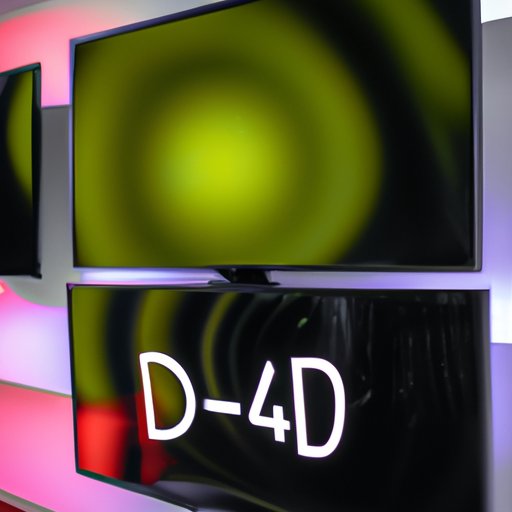Introduction
As technology advances, so does the quality of our home entertainment systems. From high-definition televisions to streaming devices, there are countless ways to upgrade your viewing experience. But with so many options available, it can be difficult to decide which TV technology is right for you. In this article, we’ll explore the cutting edge of television technology and help you find the best TV technology for your needs.

Exploring the Cutting Edge of TV Technology
When it comes to TV technology, there are two main categories: standard definition (SD) and high definition (HD). SD TVs have been around since the early 2000s and offer a basic level of picture quality. HD TVs, on the other hand, have become increasingly popular in recent years due to their improved picture quality. But now, there are even more advanced TV technologies available, such as High Dynamic Range (HDR), OLED displays, Quantum Dot Displays, 4K resolution, and WiFi connectivity.
The Top 5 Must-Have TV Technologies for the Modern Home
These five technologies are essential for any modern home entertainment system. Here’s a brief overview of each one:
High Dynamic Range (HDR)
High Dynamic Range (HDR) is a type of video signal that allows for greater contrast between dark and light areas of an image. This makes images appear more vibrant and realistic than traditional HD signals. HDR is available on both LCD and OLED TVs.
OLED Displays
Organic Light Emitting Diode (OLED) displays are a type of flat panel display that uses organic materials to generate light. They have superior picture quality compared to LCD displays, with deeper blacks and brighter colors. OLED displays are also thinner and more energy efficient than LCDs.
Quantum Dot Displays
Quantum Dot (QD) displays use nanocrystals to create incredibly vivid and accurate colors that are far superior to traditional LCD displays. These displays are also more energy efficient than LCDs, making them a great choice for those looking to save money on their electricity bill.
4K Resolution
4K resolution refers to the number of pixels a TV has. The more pixels, the higher the resolution and the better the picture quality. 4K TVs have four times the resolution of 1080p HD TVs, resulting in sharper images with more detail.
WiFi Connectivity
WiFi connectivity allows you to wirelessly stream content from your smartphone, tablet, or laptop directly to your TV. This eliminates the need for messy cables and allows you to easily access your favorite streaming services and apps.
Comparing the Leading TV Technologies
When choosing a TV technology, there are several factors to consider. Picture quality is obviously important, but sound quality, energy efficiency, and price should also be taken into account. To help you make an informed decision, here’s a quick comparison of the leading TV technologies:
- Picture Quality: OLED displays have the best picture quality, followed by Quantum Dot displays and HDR. 4K resolution provides the most detail, while standard definition TVs offer the least.
- Sound Quality: OLED displays have the best sound quality, followed by Quantum Dot displays and HDR. Standard definition TVs offer the least.
- Energy Efficiency: OLED displays are the most energy efficient, followed by Quantum Dot displays and 4K resolution. Standard definition TVs are the least efficient.
- Price: OLED displays are the most expensive, followed by Quantum Dot displays and 4K resolution. Standard definition TVs are the least expensive.
It’s important to note that these comparisons are based on average performance. Some models may perform better or worse than others, so it’s always best to read customer reviews before making your purchase.

Get the Most Out of Your Viewing Experience
Once you’ve chosen the perfect TV technology for your needs, it’s time to set up your TV for optimal performance. Here are some tips to help you get the most out of your viewing experience:
- Place your TV in a room with minimal lighting and no direct sunlight.
- Make sure your TV is at eye level. This will reduce strain on your neck and eyes.
- Calibrate your TV’s settings. This will ensure that colors and brightness levels look their best.
- Position your speakers correctly. This will ensure that you get the best sound quality.
- Use an HDMI cable for connecting your devices. This will provide the highest quality picture and sound.
Everything You Need to Know About the Best TV Technologies: A Buyer’s Guide
Now that you know what the best TV technologies are, it’s time to start shopping. Before you buy, here are a few things to keep in mind:
Understanding Terms and Jargon
There are a lot of terms and jargon associated with TV technology. To make sure you understand what you’re buying, familiarize yourself with key terms like “resolution,” “refresh rate,” and “contrast ratio.”
Finding the Right Model for Your Needs
Before you buy a TV, think about what you’ll be using it for. If you’re mainly watching movies, you may want to invest in a model with a larger screen size. If you’re gaming, you may want to opt for a model with a faster refresh rate. Knowing what you’ll be using your TV for will help you narrow down your choices.
Staying Within Your Budget
TVs can be expensive, so it’s important to stick to your budget. Fortunately, there are plenty of affordable models available. Just remember to read customer reviews to make sure you’re getting a quality product.
Conclusion
In conclusion, there are a variety of TV technologies available on the market today. From OLED displays to Quantum Dot displays, there’s something for everyone. When choosing a TV technology, consider factors such as picture quality, sound quality, energy efficiency, and price. With the right TV technology, you can enjoy a truly immersive viewing experience.
(Note: Is this article not meeting your expectations? Do you have knowledge or insights to share? Unlock new opportunities and expand your reach by joining our authors team. Click Registration to join us and share your expertise with our readers.)
